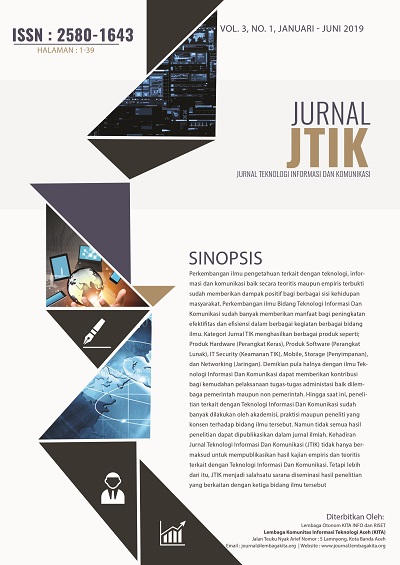Implementasi Jaringan VPN dengan Routing Protocol terhadap Jaringan Multiprotocol Label Switching (MPLS)
DOI:
https://doi.org/10.35870/jtik.v3i1.83Keywords:
Implementation, VPN, Multi Protocol Label SwitchingAbstract
The convergence of the internet and telecommunications is growing, with applications in it increasingly dependent on the availability of large bandwidth, with its QoS settings requiring networks and elements in them that provide full support for data security and increased network performance. The need for data transmission technology that not only facilitates routing and discovery of the best paths but can also provide security in data communication. This study discusses the implementation of VPN networks with routing protocols on the Multiprotocol Label Switching (MPLS) network. After implementation, MPLS network performance will be tested and compared to performance without MPLS using the model planned by the researcher. The specific purpose of this study is to show how routing protocols play an important role in strengthening data communication traffic management that supports MPLS capabilities of VPN networks and is applied to the AMIK Indonesia network architecture. This research will use the literature study method which is intended to obtain and study data contained in computers connected to networks in the AMIK Indonesia computer network laboratory. The conclusion obtained from this study is that MPLS VPN provides bandwidth efficiency in the backbone, MPLS VPN network applications have functioned functionally according to the initial plan of the study and the authors have also managed to configure different networks and obtain stable bandwidth.
Downloads
References
Border, J., Dillon, D. and Pardee, P., Hughes Network Systems LLC, 2015. Method and system for communicating over a segmented Virtual Private Network (VPN). U.S. Patent 8,976,798.
Cisco Systems Learning. 2006. Implementing Secure Converged Wide Area Networks (Volume 1). San Jose : Cisco Systems Inc.
Hikmaturokhman, A., Pamungkas, W. and Berlianti, L., 2015. Analisa Model Propagasi Cost 231 Multiwall pada Perancangan Jaringan Indoor Femtocell HSDPA menggunakan Radiowave Propagation Simulator. Purwokerto: Sekolah Tinggi Teknologi Telematika Telkom.
Safitri, R., 2010. Implementasi dan Analisa Perbandingan QoS pada Jaringan VPN Berbasis MPLS menggunakan Routing Protocol RIPv2, EIGRP dan OSPF terhadap Tunneling IPsec untuk Layanan IP-Based Video Conference. Universitas Indonesia. Jakarta.
Sari, L.O., Safrianti, E. and Adhil, I.F., Analisa Perbandingan Pengaruh Routing Protocol Ipv4 Dengan Ipv6 Studi Kasus Jaringan Data PT. PERTAMINA RU II DUMAI. Skripsi. Universitas Indonesia.
Sismoro, H. and Artha, E.U., 2016. Perancangan Dan Implementasi Static Tunnel Sebagai Media Pembelajaran Jaringan Komputer Menggunakan Dual Stack. Data Manajemen dan Teknologi Informasi (DASI), 17(1), pp.27-32.
Stiawan, D. and Rini, D.P., 2009. Optimalisasi Interkoneksi VPN Menggunakan Hardware Based dan Iix (Indonesia Internet Exchange) Sebagai Alternatif Jaringan Skala Luas (WAN). Jurnal Generic, 4(1), pp.57-68.
Supriyadi, A. and Gartina, D., 2007. Memilih Topologi Jaringan Dan Hardware Dalam Desain Sebuah Jaringan Komputer. Informatika Pertanian, 16(2), pp.1037-1053.
Downloads
Published
Issue
Section
License
Copyright (c) 2019 Jurnal JTIK (Jurnal Teknologi Informasi dan Komunikasi)

This work is licensed under a Creative Commons Attribution-NonCommercial 4.0 International License.
Copyright and Licensing Agreement
Authors who publish with this journal agree to the following terms:
1. Copyright Retention and Open Access License
- Authors retain full copyright of their work
- Authors grant the journal right of first publication under the Creative Commons Attribution 4.0 International License (CC BY 4.0)
- This license allows unrestricted use, distribution, and reproduction in any medium, provided the original work is properly cited
2. Rights Granted Under CC BY 4.0
Under this license, readers are free to:
- Share — copy and redistribute the material in any medium or format
- Adapt — remix, transform, and build upon the material for any purpose, including commercial use
- No additional restrictions — the licensor cannot revoke these freedoms as long as license terms are followed
3. Attribution Requirements
All uses must include:
- Proper citation of the original work
- Link to the Creative Commons license
- Indication if changes were made to the original work
- No suggestion that the licensor endorses the user or their use
4. Additional Distribution Rights
Authors may:
- Deposit the published version in institutional repositories
- Share through academic social networks
- Include in books, monographs, or other publications
- Post on personal or institutional websites
Requirement: All additional distributions must maintain the CC BY 4.0 license and proper attribution.
5. Self-Archiving and Pre-Print Sharing
Authors are encouraged to:
- Share pre-prints and post-prints online
- Deposit in subject-specific repositories (e.g., arXiv, bioRxiv)
- Engage in scholarly communication throughout the publication process
6. Open Access Commitment
This journal provides immediate open access to all content, supporting the global exchange of knowledge without financial, legal, or technical barriers.












